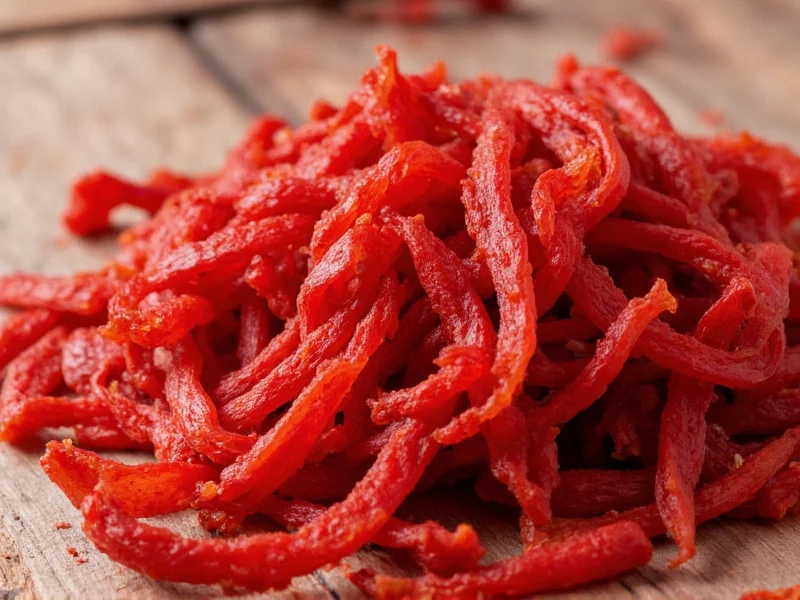Chamoy represents one of Mexico's most beloved condiments, captivating taste buds with its complex flavor profile that balances sweet, sour, salty, and spicy elements. This vibrant sauce or seasoning has become increasingly popular beyond Mexican borders, appearing in everything from street food to gourmet culinary creations. Understanding what chamoy is made out of reveals not just a simple recipe, but a culinary tradition with deep cultural roots.
The Essential Components of Traditional Chamoy
At its core, chamoy begins with dried, salted fruit. While modern commercial versions sometimes use fruit purees or extracts, authentic chamoy relies on whole fruits that undergo a specific preservation process. The fruit selection significantly influences the final product's character, with regional variations across Mexico showcasing local preferences.
| Primary Ingredient | Traditional Source | Function in Chamoy |
|---|---|---|
| Fruit Base | Mango, apricot, plum, or prunes | Provides natural sweetness and tartness |
| Preservative | Sea salt | Draws out moisture and begins preservation process |
| Acid Component | Lime juice or vinegar | Creates tangy flavor and aids preservation |
| Heat Element | Chilies (typically árbol or de árbol) | Provides signature spicy kick |
| Sweetener | Sugar or piloncillo (unrefined cane sugar) | Balances sour and salty elements |
Traditional Preparation Process
The authentic method of making chamoy involves several stages that transform simple ingredients into a complex condiment. First, ripe fruits are coated in salt and left to dry in the sun for several days. This salting process draws out moisture while beginning preservation. The dried fruits then undergo rehydration with a mixture containing chili powder, tamarind paste, and vinegar.
What gives chamoy its distinctive flavor is the fermentation that occurs during this rehydration phase. The combination of salt, acid, and natural fruit sugars creates an environment where beneficial bacteria develop, enhancing both flavor complexity and shelf stability. This traditional preparation process for chamoy sauce composition differs significantly from commercial versions that often skip fermentation for efficiency.
Regional Variations Across Mexico
Mexico's diverse regions have developed their own interpretations of what chamoy is made out of. In Oaxaca, chamoy often features tejocotes (a type of hawthorn fruit) and incorporates local chilies for a distinctive flavor. Northern regions frequently use apricots or prunes, while coastal areas favor mango as the primary fruit base.
These regional differences in homemade chamoy recipe ingredients reflect local agricultural availability and cultural preferences. Some versions include additional elements like tamarind paste for extra tartness or sesame seeds for texture. Understanding these variations helps explain why no single "authentic" chamoy recipe exists—it's a living culinary tradition that adapts to local contexts.
Commercial vs. Traditional Chamoy
When examining what is chamoy made out of in store-bought versions versus traditional preparations, significant differences emerge. Commercial producers often substitute the lengthy drying and fermentation process with shortcuts:
- Using fruit concentrates instead of whole dried fruits
- Adding artificial flavors and colors to standardize appearance
- Including preservatives like sodium benzoate for extended shelf life
- Using vinegar rather than natural fermentation for sourness
These modifications create a more consistent product but often sacrifice the nuanced flavor development that occurs in traditional preparation. Many commercial chamoy products also contain thickeners like xanthan gum to achieve the desired consistency without the natural pectin from properly prepared fruit.
Modern Applications and Culinary Uses
Today, chamoy appears in increasingly creative applications beyond its traditional role as a fruit dip. Chefs incorporate it into:
- Marinades for meats and seafood
- Glazes for roasted vegetables
- Base for salad dressings and dipping sauces
- Flavoring for cocktails and specialty beverages
- Ingredient in gourmet popsicles and desserts
Understanding chamoy seasoning components helps explain its versatility in modern cuisine. The balance of sweet, sour, salty, and spicy elements makes it an excellent flavor enhancer that complements rather than overwhelms other ingredients. When selecting chamoy for culinary applications, examining the ingredient list reveals whether it contains natural components or relies on artificial substitutes.
Is Chamoy Vegan and Allergen Information
Most traditional chamoy recipes are naturally vegan, containing only fruit, chilies, salt, sugar, and acid components. However, some commercial varieties may include non-vegan ingredients like honey or dairy derivatives. When determining if chamoy is vegan friendly, always check the ingredient list for unexpected additions.
From an allergen perspective, traditional chamoy ingredients pose minimal risks, though some commercial versions may contain sulfites as preservatives. The primary concern for most consumers is the chili content, which can vary significantly in heat level depending on the specific chilies used in the chamoy preparation process.











 浙公网安备
33010002000092号
浙公网安备
33010002000092号 浙B2-20120091-4
浙B2-20120091-4